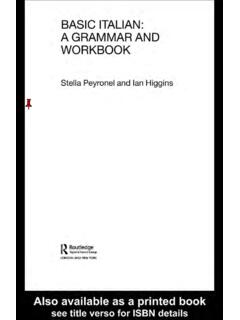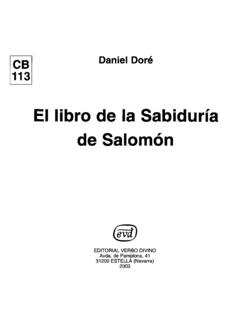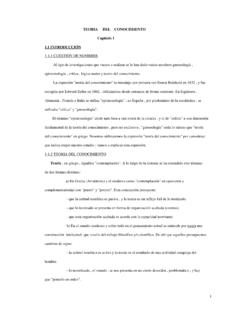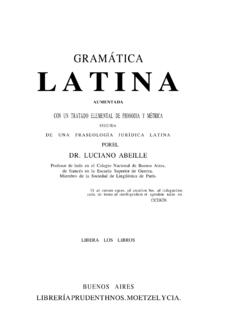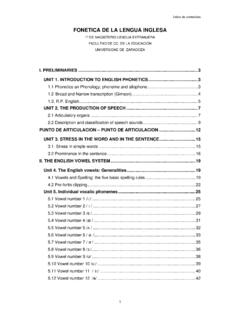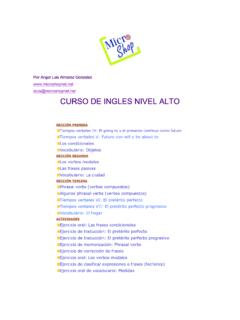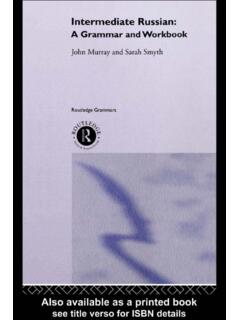Transcription of Basic German: A Grammar and Workbook
1 Basic German: A Grammar AND WORKBOOKB asic German: A Grammar and Workbook comprises an accessiblereference Grammar and related exercises in a single introduces German people and culture through the medium of thelanguage used today, covering the core material which students wouldexpect to encounter in their first years of learning of the 28 units presents one or more related Grammar topics,illustrated by examples which serve as models for the exercises thatfollow. These wide-ranging and varied exercises enable the student tomaster each Grammar point German is suitable for independent study and for class include.
2 Clear grammatical explanations with examples in both English andGerman Authentic language samples from a range of media Checklists at the end of each Unit to reinforce key points Cross-referencing to other Grammar chapters Full exercise answer key Glossary of grammatical termsBasic German is the ideal reference and practice book for beginners butalso for students with some knowledge of the Schenke is Senior Lecturer in German at the University ofWestminster and Karen Seago is Course Leader for Applied Translationat the London Metropolitan titles available in the Grammar Workbooks series are: Basic CantoneseIntermediate CantoneseBasic ChineseIntermediate ChineseIntermediate GermanBasic PolishIntermediate PolishBasic RussianIntermediate RussianBasic WelshIntermediate WelshTitles of related interest published by Routledge:Colloquial Germanby Dietlinde Hatherall and Glyn HatherallModern German Grammar : A Practical Guide, Second Editionby Bill Dodd, Christine Eckhard-Black, John Klapper, Ruth WhittleModern German Grammar Workbook , Second Editionby Heidi Zojer, Bill Dodd, Christine Eckhard-Black, John Klapper,Ruth WhittleBASIC GERMAN.
3 A Grammar ANDWORKBOOKH einer Schenke and Karen SeagoFirst published 2004by Routledge11 New Fetter Lane, London EC4P 4 EESimultaneously published in the USA and Canadaby Routledge29 West 35th Street, New York, NY 10001 Routledge is an imprint of the Taylor & Francis Group 2004 Heiner Schenke and Karen SeagoAll rights reserved. No part of this book may be reprintedor reproduced or utilised in any form or by any electronic, mechanical,or other means, now known or hereafter invented, includingphotocopying and recording, or in any information storage orretrieval system, without permission in writing from the Library Cataloguing in Publication DataA catalogue record for this book is available from the British LibraryLibrary of Congress Cataloging in Publication DataA catalogue record for this book has been requestedISBN 0 415 28404 X (hbk) 0 415 28405 8 (pbk)This edition published in the Taylor & Francis e-Library, 2005.
4 To purchase your own copy of this or any of Taylor & Francis or Routledge scollection of thousands of eBooks please go to ISBN 0-203-64270-8 Master e-book ISBNISBN 0-203-67466-9 (Adobe eReader Format)CONTENTSP refacevii1 What s different in German? Basic tips and patterns12 Verbs in the present tense63 Verb variations and irregular verbs124 Irregular verbs: haben and sein195 Separable verbs in the present tense246 Imperatives307 Questions368 Nouns and gender429 Plural of nouns5010 The four cases5611 The nominative case6212 The accusative case6513 The dative case7014 The genitive case7515 Personal pronouns7916 Possessive adjectives8717 Reflexive verbs9218 Negatives9719 Comparison of adjectives and adverbs10220 Modal verbs10921 The present perfect tense11622 The simple past tense12423 The future tense13024 Prepositions13525 Adjective endings14326 Numbers and dates15127 Conjunctions and clauses15828 Word order167 Key to exercises and checklists175 Glossary of grammatical terms200 Common
5 Irregular verbs203 Index205vi ContentsPREFACEB asic German is aimed at absolute beginners and those learners who havesome knowledge of German but who need to refresh and consolidate basicstructures. It can be used on its own or in connection with any major Germancoursebook and it is suitable for self-study, class-based learning or of grammarThe book explains the essentials of German Grammar in clear and simplelanguage. The format is easily accessible and Grammar topics follow a pro-gression, which moves from simple aspects to more complex features. Formore in-depth study, there are cross-references to related Grammar are simple and avoid specialised terminology while introducingkey terms.
6 The vocabulary is practical and functional. It is introduced on acumulative basis and builds on vocabulary associated with topics featured inmajor course of unitsThere are 28 units. Each unit covers one key Grammar topic, which is con-trasted with English structures where appropriate. Each topic starts out withan overview. This is followed by detailed explanation in an easy-to-followstep-by-step layout, breaking down complex aspects into simple in English and German illustrate each point and introduce and exercisesIntegrated exercises allow immediate practice to consolidate each grammarpoint. Exercises are varied and progress from simple recognition to morecomplex application of Grammar checklist at the end of each unit reinforces main points and provides anopportunity to self-assess understanding of the material to all exercises and checklists are at the end of the the book as a Grammar referenceUnit headings indicate which Grammar point is covered, and the glossaryprovides clear definitions and simple explanations of key grammatical appropriate, cross-references are provided within featuresUnit 1 highlights some Basic principles where the structures of German arefundamentally different from English.
7 It explains their characteristics insimple terms and draws attention to underlying patterns. Extra tips on howto learn a language and learning specific Grammar points are provided in thisunit and throughout the book is suitable for independent learners GCSE preparation AS/A-level revision beginners courses at university and in further education adult education PrefaceUNIT ONEWhat s different in German? Basic tipsand patternsLearning German is often perceived as difficult. In 1880, Mark Twainfamously dubbed it the awful German language , protesting Surely there isnot another language that is so slipshod and systemless, and so slippery andelusive to the grasp (Mark Twain, The awful German language , The TrampAbroad, 1880 (Harmondsworth: Penguin 1997), pp.)
8 390 402).But is this really the case? One thing that is very helpful in learning Germanis that it is a systematic language, which follows rules. There are many ways tomake these rules easier to learn, and there are quite a few tips which will helpyou in learning the you approach the language step by step you will find that it is mucheasier than you may think at the beginning. Here are pointers to some basicprinciples where German is different from English, and which may be usefulbefore you start out with the Grammar capital letters and different charactersThere are a few ways in which German spelling is different from letters for nounsGerman is one of the few languages which uses capital letters not only atthe beginning of sentences but also within sentences.
9 In English, this appliesonly to proper names, to the personal pronoun I and to personifications,such as Love .In German, all nouns must always be written with a capital letter, regard-less of whether they are at the beginning of a sentence or in the middle:Der Mann und die Frau arbeiten jeden Tag am man and the woman work at their computer every that the pronoun ich ( I ) has no initial capital in German, but Sie(formal form of you ) charactersThe German alphabet has some characters which do not exist in the Englishalphabet: the sharp s The letter , called eszett in German, is pronounced like the normal English s , for example in sun or Basic .
10 German uses this letter for instance after ei and ie, and after a, o, u if theyare pronounced long:hei ento be calledStra estreetgro bigThe umlauts , , These are very important. They change the pronunciation of a word and,more importantly, its meaning:Mutter means mother , but M tter is the plural form and means mothers . Musste means had to, but m sste means should or ought to .Three gendersAll nouns in German are masculine, feminine or neuter. This shows in theirsingular article: der for masculine, die for feminine, das for is important to realise that gender in German is grammatical, notbiological as it is in English. This means that objects, concepts etc.
